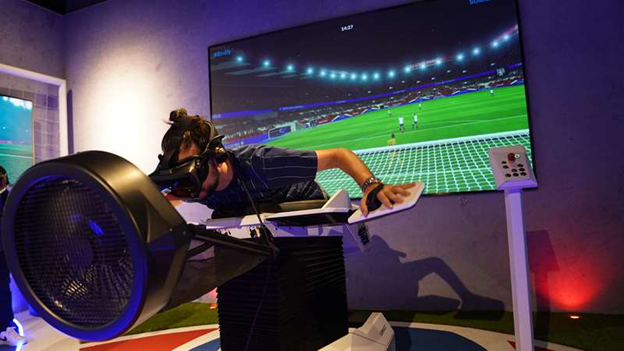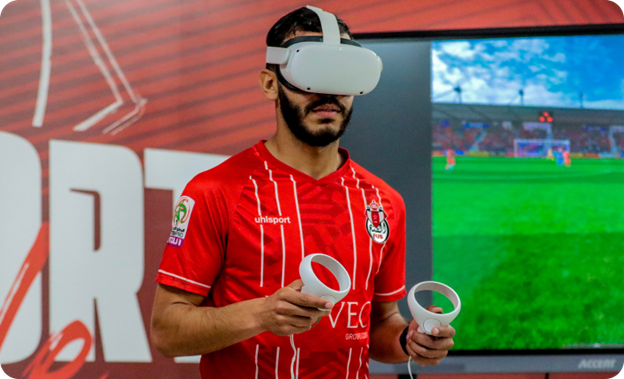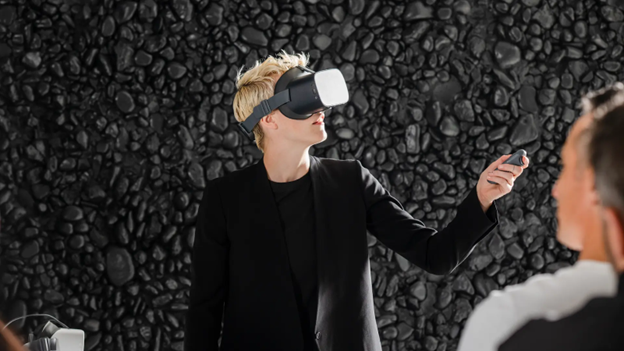There I was, sitting at the edge of a cliff, feeling every single heartbeat pounding in my chest. The noise of distant rumble of rails distinctively repeated in my ears, and before I could gather my thoughts and take another breath, I was sent underground. Wind was rushing through my face, the hair-raising experience of swinging down a roller coaster at headlong speed, and the stumble in my stomach started to horrify me. No one knew I was standing in the middle of my classroom in reality, showing 50 forms of expressions, and wearing a VR headset that delivered me to an environment where gravity was non-existent.
This wasn’t just a game, it was a door opened to a world of possibilities. I realized that the fundamental senses we experience in the real world including sight, sound and sometimes a sense of motion were replicated with high precision through a single pair of goggles. My brain was completely controlled and “manipulated” by the immersive visual and auditory feedback delivered by the VR headset that made me totally forget about the limitations of such a device when it comes to the absence of physical sensation like touch or the actual force of gravity. As I removed the headset, it wasn’t just the adrenaline from the ride that left an impact. What struck me most was the promising values of virtual reality technology to reshape how we perceive reality through a programmed environment and its potential for access and equity within the field of sports.
Nowadays, VR, AR, and MR technology are not only mentioned alongside the field of gaming or entertainment but their boundaries have been erased and expanded into more confined sectors like sports. The development of specialized VR products has revolutionized the field of sports and reshaped the accessibility of such programs to individuals. However, the crucial question is: Will the proliferation of these VR technologies result in a broader and greater access and equity, or will it exacerbate existing disparities? The blog will examine whether this up-and-coming digital revolution is truly as transformative as it committed to be.
Breaking barriers in Sports: The potential of Virtual Reality
Within the world of sports there exists the physical, geographical, and economic barriers that restrict accessibility and participation from people worldwide. Growing up in Vietnam, I observe many children who live in mountainous areas dream of becoming professional athletes, but only a small percentage of those talented individuals have the fundamental resources to attend live matches, afford certified and high-quality training, and enroll in elite sports programs that provides a pathway for them to pursue a career in sports. Fortunately, the presence of VR has opened a gate to accessible and affordable routes for sport enthusiasts.
With VR, fans can virtually attend live games from anywhere in the world. Different from traditional viewing broadcast experiences, VR live matches provide access to fans who never have a chance to sit in on a game in person with all the fundamental senses fostered. Such experience would undoubtedly satisfy and complete the long-wanted dream of sports fans who always desire to be at the stadium for an official match. At the moment, Paris Saint-Germain, an elite football club in France has started utilizing VR for an immersive match experience for fans globally. The program enables the supporters from remote regions to feel as if they are sitting in the Parc de Prince stadium. Such development in technology has erases the barriers of economic and geographical. Wider segment of the audience now have the opportunity to engage with top-tier sports at a level previously unheard or reserved for only those who have the ability to travel and pay for tickets. There could be much more cost effective opportunities to have these experiences.

Furthermore, VR doesn’t only encourage fan engagement, but also promises revolutionary opportunities for athletic training and networking. Brazil was long known for its home to world-known footballers whose childhood started under poverty or lived under the roof of a slum. Only a small portion of these talented athletes were recognized by scouts and coaches around the world, leaving behind the majority of other promising potential star players just because of the inaccessible training program. A re-gen of Neymar who is a young footballer in rural Brazil but doesn’t have access to professional programs and facilities. Fortunately, with the breakthrough of VR into the segment of sports, these aspiring athletes could train using simulated environments that could replicate high-level game play, receive virtual feedback from elite coaches, and even participate in cyber competitions against other players globally to gain more experience. Leading the current VR sport training market is Be Your Best, a platform that enables athletes to accumulate 1000s of extra repetitions in a dynamic, deep-learning environment where they can practice, perfect, and create real muscle memory. With real-on field simulations, the company’s reports show that 28% of the participants increase in scan rate is the average improvement that players experience from training with Be Your Best, 9 weeks is the time it takes players to achieve this improvement, and result in 2x increase in Forward Pass Completion. Priced at $29 per month or $19 monthly for annual subscription, “Be Your Best” has revolutionized the field of sports training, providing accessible practice sessions that complement physical training, even during injury recovery periods. The image below shows an example of the reports from the “Be Your Best” program after 6 months of training. We can see the in-depth analysis and tracking data of the application, which leads to detailed reports for athletes and coaches to determine their improvements and identify their weaknesses. With the impressive outcome of utilizing such innovative VR technology alongside with traditional training, talented athletes could conveniently but productively improve their skills anywhere without the need of physical facilities and interactions with coaches.

Be Your Best | How it Works | VR Football/Soccer Training
However, the lack of tactile feedback that remains as a limitation for VR training is a major factor that is resisting athletes from adopting such mnemonic devices into their official training program. As Deroy stated in her article, touch is a fundamental aspect of sensory for a reality-based experience and offers a unique psychological reassurance that other senses like that of vision can not bring. For that young footballer in rural Brazil who decided to use VR for skill enhancement, it is undeniable that the experience might be visually immersive. Unfortunately, VR can not yet replicate the feel of the grass underfoot, the force of the ball against the shoes, and the physical contact that exists in physical training with other players. The lack of elements above make VR training still fall short of replicating the physical world experience necessary to prepare athletes fully for actual gameplay. If VR developers could extend their devices into a one-size-fit-all training program that include all 5 senses of fundamental sensory that exist in the physical world, VR sports training promises to be the next milestone for the sports industry. However, if the current limitation continues to exist, VR training will only play a role as an additional or extra method besides real-life training for professional athletes. In other words, it can never fully replace traditional training.

Moreover, VR is not restricted only to the revolution of fan experiences and athlete training, but its impact extends to the officials who uphold the integrity of the game. Such practice of VR being utilized in sports has been in action at the English Football Association where referees were deployed into the cyberworld through VR headset to be trained through experiencing match scenarios and improving their decision making skills without the need of stepping onto an official match. This application of VR for sports training helps to avoid unwanted criticism from fans and players for unjustified decision making or unfairness during the tournament. Likewise, sports academies around the world have now been employing VR to enhance player development. Through simulating real-life obstacles and providing instant, precise data-based feedback, the usage of VR has helped to step up the game of sports.

Nevertheless, it is undeniable that VR is providing greater access for humanity in various aspects of life, there are some challenges remaining. First, the present cost of VR is still prohibitive for a large segment of the population. VR is a barrier to entry for most people with its unavailability and unaffordable price of headsets with reliable internet connectivity. In parts of the world where low-income existed as the primary problem of the region, such scarcity of accessibility could even foster a wider gap between different society classes. Governments and companies should address these financial hurdles to make VR accessible for everyone to enhance equality for global citizens. According to this study, VR training initially cost more than traditional training - $327.78 per person compared to $229.79. But on the brighter side, when these costs were spread out over a three-year period with repeated use of the training program, the expense of VR training dropped significantly to $115.43 per person. However, such costs would still be considered to be expensive for those who live under harsh conditions. Even in developed countries such as the US, according to another study, the March 2022 Morning Consult survey of 4,420 US adults, half of the respondents indicated they would like to see VR technology become more affordable before considering entering the metaverse. In the survey, 24% stated that having lower-priced headsets is “very important” to their decision, while 26% said that reduced costs are “somewhat important” in determining whether they’ll participate in the metaverse.

Addressing the Barriers: Cost, Infrastructure, and Digital Literacy
In order to make VR into a technology that is for inclusion rather than exclusion, three primary challenges below would be addressed: cost, infrastructure, and digital literacy.
- Reducing the cost of VR technology is essential for its widespread adoption in sports. Technology companies, governments, and NGOs should collaborate to make VR devices more accessible for sport-related activities. Potential solutions include subsidies, public-private partnerships, or bulk production to result in economies of scale for price reduction in sport programs that integrate VR. In addition to that, countries should turn their attention and invest more in developing low-cost VR hardware and software that is more affordable for a wider range of athletes, coaches, and fans.
- In underdeveloped countries where sport facilities and technology is considered as an underserved region, the digital infrastructure should be improved. The deployment of breakneck speed interior and reliable electricity is a fundamental target. For instance, in rural areas of India and Africa where internet penetration is restricted to a certain extent, investments on broadband expansion are urgent. The potential benefits of VR will forever remain out of reach for underprivileged regions if such problems continue to exist. The potential of VR to democratize access to world-class sports experiences will remain out of reach for many.
- Strengthening the digital literacy program is also an important goal for the development of VR in sports. Even though VR can transform complex concepts into a more comprehensive knowledge, foundational information is still a must-have background to make the most of these tools. Opening digital literacy initiatives can educate a broader audience to engage with VR technologies adequately, avoiding the undermining benefits that these tools bring to the table. VR promises to become a powerful tool for expanding access and equity in sports worldwide.
A path forward: Balancing optimism with realism
The current controversial debate about whether VR will foster more access and equity in sports is unanswerable. On one hand, the existence and promise for democratization is vast where VR and transform traditional real life experience into a virtually generated environment under a headset. Such development promises to provide new avenues for studying, participation, and erasing the long-lasted barriers that correspond with geography, economics and privilege. On the other hand, existing challenges related to VR are considerable. We must ensure that VR doesn’t just simply replicate existing inequality in an alternate world. They should be leveraged to dismantle barriers and form a more inclusive world.
I can resonate my virtual roller coaster ride to that of the journey of VR that promises to bring to the future: full of unexpected twists and turns. Even though the destination is uncertain, it definitely provides an unforgettable chance to redefine access and equity in ways people could have never imagined. Whether we reach the dream destination depends on the way we choose to tackle and navigate the challenges along the way.
Image Sources:
Headline Image
Image 1
Image 2
Image 3
Image 4
Image 5


